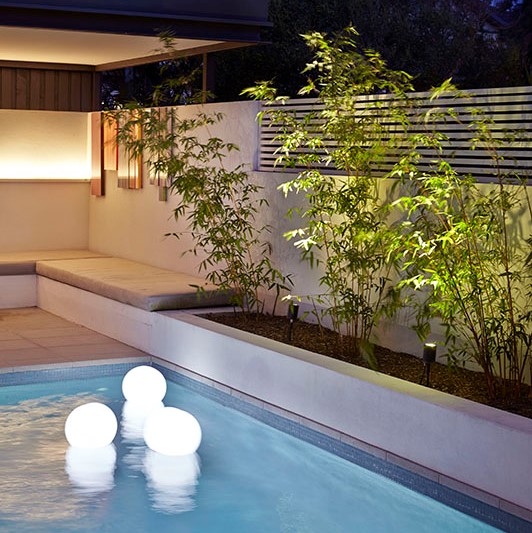The magic of lighting is transformative. With Sydney’s dazzling light show, ‘Vivid’, due to brighten the skies this month, we at Pepo thought it was a good time to share our best tips for creating a luminous display in your outdoor space.
-
Identify the atmosphere you want to create
Good lighting is comparable to adding brush strokes to a canvas. It can brighten or camouflage every small detail, just like painting a picture. Whether you’re aiming for excitement, drama, depth or safety, smart planning sits at the heart of a beautifully lit landscape.
Making a conscious decision about the feeling you are trying to create will deliver the best results.
 Image- iGuzzini illuminazione
Image- iGuzzini illuminazione
The architecture of your home is the starting point to inform good lighting choices. “I begin by reviewing the overall space and thinking about what sort of atmosphere we want to evoke,” says Nicola Cameron from Pepo Botanic Design. “There needs to be a seamless flow between the planting, hard materials and the home. We are always striving for a complementary and natural design.”
-
Highlight your garden’s best features
Beautiful lighting can turn an uninspiring corner into a sparkling oasis and enlighten the plainest of spaces in any garden. Firstly, think about what you want to highlight. Perhaps it’s a sculptural piece or a beautiful tree? Then create a hierarchy of lighting, to establish depth and harmony. Consider which tones of light will enhance your chosen features. Do you want to integrate reflections or lengthen a tree to make a statement?
Identify your garden’s best features and areas that deserve an emphasis.
“At Pepo, we start by incorporating a luminous wash which creates an evenly lit canvas,” says Nicola Cameron. “Then, we create the layers by carefully spot-lighting individual elements. It is important to do this gradually and remember that ‘less is more’ when it comes to creating a balanced and pleasing result.” Pepo adopted this approach when developing a lighting design for this garden below, in McMahons Point in Sydney. 
-
Choose the right lighting
Garden lighting needs to be balanced and comfortable, rather than confusing. Flood lights for example tend to blast the entire space and can be harsh and uncomfortable. Your landscape designer can advise on the best choice for you, as part of your particular design. Do you need to guide visitors along a path at night? Does a gate have to be well lit?
These insights will help to determine whether vertical or horizontal lighting is required. Horizontal placement assists people to see obstacles or trip hazards on the ground. Meanwhile, vertical lighting can help with recognising the facial features of approaching people. It also highlights the depth of obstacles, like steps.
As well as balance, it’s important to spend time assessing the practical elements.
Luminaire selection needs particular consideration when lighting stairs, given the importance of both the vertical and horizontal planes. “When Pepo planned the lighting for this garden (pictured below), we installed strategically placed downlights on the wooden steps, aware of the need to illuminate different surfaces at the one time,” says Nicola.  On the whole, light fittings should be hidden, with an emphasis on the illumination, not the fixture. There are some exceptions however, such as sculptural or festoon lights, which are designed to be noticed and appreciated.
On the whole, light fittings should be hidden, with an emphasis on the illumination, not the fixture. There are some exceptions however, such as sculptural or festoon lights, which are designed to be noticed and appreciated.
Lighting options Spike lights – perfect for garden beds to up-light plants or features. Bollard lighting – ideal for lighting paths or driveways.
Festoon lights – selected to create a twinkling canopy and highlight an entertaining area.
Spotlights – perfect to shoot up the trunk of a tree or highlight architectural features.
Projection lights – helpful for creating interest and playful patterns on walls or ground surfaces.
Strip lighting – ideal when beaming a wash of light along a wall, seat or horizontal feature.
Sculptural lights – perfect to create a feature of the light itself using playful and interesting fittings. Examples include hurricane lamps and LED balls, like those floating in the pool of this garden below.  Lighting Effects Tony Lambrechtsen from the lighting company iGuzzini, says there are three main options to consider when selecting lighting effects:
Lighting Effects Tony Lambrechtsen from the lighting company iGuzzini, says there are three main options to consider when selecting lighting effects:
- Static lighting, using set luminaires and colour temperatures;
- Coloured lighting, using RGB LEDs which combine red, green and blue to create any shade of the rainbow and;
- Mood enhancing lighting, created by controlling the light colour temperature, (cool to warm), and by using dimmers, for example.
These effects can be used individually or combined, to create a variety of garden lighting experiences.
-
Select the best power source
Lighting technology has come a long way in recent years. Not only are outdoor fixtures safer now, but a much wider range is available allowing for greater variation and creativity. The most reliable and consistent way to power lighting is through the mains source, connected by a professional or electrician.
Other options include battery or solar powered means which are cheaper options, but less dependable. When using LEDs, yellow light is more relaxing than white light which can drain surfaces of tone and texture.
LED lighting has greatly extended the scope of outdoor lighting and uses 90% less power than traditional lights.
It’s important to consult with lighting experts, such as Gardens at Night or LightCo, to ensure you are using quality fittings with a good warranty. Cheaper products may not be properly joined or sealed, putting you at risk of excess moisture which may cause the light to blow.
Professionals, such as Pepo Botanic Design, will also ensure that the wattage and power source you select are appropriate when creating your plans. Additional considerations such as light automation and dimmers are excellent inclusions to create variation in mood. These additions should be discussed at the start of the project with your lighting professional and landscape designer. 
-
Plan your budget
Lighting is an essential part of a beautiful landscape design and it’s important to allocate a portion of your budget at the start of the project. “We recommend on average that our clients set-aside at least 5% of the total cost of the garden design, for their lighting requirements,” says Nicola Cameron. “Not only does this allow for a luminous outdoor vista, it ensures they will get ample use of their garden after dark.”
Enjoying your garden in the evening is one of the greatest benefits of outdoor lighting.
-
Consider the environment
Darkness can be a landscape designer’s true friend. It provides the opportunity for contrast and allows for a unique balance of light and shade when creating the perfect garden picture. “A campaign to promote outdoor darkness is currently gaining momentum, known as the ‘dark-sky movement’,” says Nicola. “It supports the growing trend we are seeing to reduce light pollution and designers are increasingly taking note.”
Advocates of the campaign encourage the thoughtful use of lighting, aiming to make the night time sky more visible and reduce energy and power usage.
One of the major causes of light pollution are fixtures that beam light upwards. Increasingly, landscape architects are integrating shielded lights that direct luminosity downwards, as well as filtered fittings and capped bollard fixtures. 
Image- iGuzzini illuminazione
Whatever your choice of lighting, well considered placement and a thoughtful design will naturally enhance your connection with nature.
Not only will the added luminosity visually-shape your outdoor space, it will extend your time in the garden well into the evenings and deliver lasting inspiration. For more examples of our garden projects CLICK HERE.

